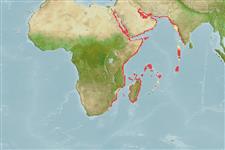Environment: milieu / climate zone / Tiefenbereich / distribution range
Ökologie
seewasser riff-verbunden; tiefenbereich 0 - 30 m (Ref. 30573). Tropical
Western Indian Ocean: Red Sea to at least the coast of Somalia.
Size / Gewicht / Alter
Geschlechtsreife: Lm ? range ? - ? cm
Max length : 22.0 cm SL Männchen/unbestimmt; (Ref. 30573)
Rückenflossenstacheln (insgesamt) : 12; Rückenflossenweichstrahlen (insgesamt) : 9; Afterflossenstacheln: 3; Afterflossenweichstrahlen: 5; Wirbelzahl: 24. Body heavily pigmented with dark brown or reddish brown, mottled with whitish and blackish blotches; often with a dark brown bar extending ventrally from posterior half of eye and broadening onto lower cheek. Upper opercular spine broad with a strong median ridge. Space between opercular spines with 1 or more ridges. Paired interorbital ridges prominent, separated by a channel more than twice width of 1 ridge, and ending at a ridge extending medially from postocular spine along incurved edge of moderately deep occipital pit. An oblique ridge lateral to each interorbital ridge from above middle of orbit, converging posteriorly with interorbital ridge. Tympanic spines about as long as postocular spines, close behind but separated from ridge extending medially from postocular spines. Median interorbital ridge prominent, reaching well into anterior interorbital space. First and 2nd suborbital spines oblique, sharply ridged, and with supplemental ridges. (Ref. 42181).
Body shape (shape guide): fusiform / normal; Cross section: oval.
Benthic to at least 30 m (Ref. 30573).
Life cycle and mating behavior
Geschlechtsreife | Fortpflanzung | Ablaichen | Eier | Fecundity | Larven
Randall, J.E and W.N. Eschmeyer, 2001. Revision of the Indo-Pacific scorpionfish genus Scopaenopsis, with descriptions of eight new species. Indo-Pac. Fish. (34):79 p. (Ref. 42181)
IUCN Rote Liste Status (Ref. 130435: Version 2025-1)
Bedrohung für Menschen
Harmless
Nutzung durch Menschen
Tools
Zusatzinformationen
Download XML
Internet Quellen
Estimates based on models
Preferred temperature (Ref.
123201): 24.9 - 29.1, mean 27.4 °C (based on 792 cells).
Phylogenetic diversity index (Ref.
82804): PD
50 = 0.5000 [Uniqueness, from 0.5 = low to 2.0 = high].
Bayesian length-weight: a=0.01288 (0.00620 - 0.02676), b=3.03 (2.86 - 3.20), in cm total length, based on LWR estimates for this (Sub)family-body shape (Ref.
93245).
Trophic level (Ref.
69278): 4.2 ±0.8 se; based on size and trophs of closest relatives
Widerstandsfähigkeit (Ref.
120179): mittel, Verdopplung der Population dauert 1,4 - 4,4 Jahre. (Preliminary K or Fecundity.).
Fishing Vulnerability (Ref.
59153): Low vulnerability (17 of 100).
🛈
